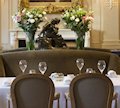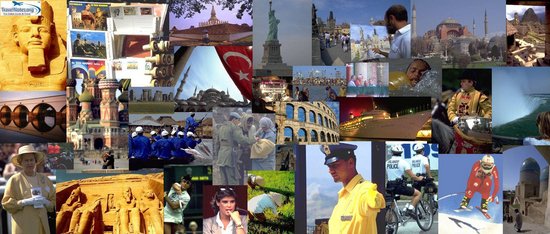Travel Notes: Destinations: Europe: France - Champagne Travel Guide.
Short URL: https://tnot.es/Reims
Travel Guide For Visitors to Champagne
The best times to visit are May to June and late summer, when Champagne houses offer tastings and tours. Cities to explore include Reims, Épernay, and Aÿ. Share on Facebook
Discover The Real Champagne, France
Where sparkling wine meets rolling hills and centuries of tradition; discover why Champagne is so much more than just a glass of bubbles.
 Add a Business -
Add a Location -
Add a Lodging - Add Travel Content
- Add URL
- Travel Services.
Add a Business -
Add a Location -
Add a Lodging - Add Travel Content
- Add URL
- Travel Services.
Drinking in The Region of Champagne, France
Forget everything you think you know about Champagne.
Yes, it's the birthplace of those celebratory bubbles, but this north-eastern French region offers visitors medieval towns, underground chalk cellars, and some of the most prestigious vineyard tours in the world.
Whether you're a wine enthusiast or simply curious about French culture, Champagne delivers an experience that's refreshingly different from the typical French tourist tramping trail.
Why Visit Champagne?
While Bordeaux gets the wine tourism glory and Burgundy attracts the connoisseurs, Champagne quietly offers something unique; the chance to explore the birthplace of the world's most famous sparkling wine, whilst discovering charming towns that most tourists never see.
The region's proximity to Paris (just 90 minutes by train) makes it perfect for day trips, though staying longer reveals hidden gems worth savouring.
Getting to Champagne
By Car
The A4 motorway connects Paris to Reims in about 1.5 hours.
Having a car opens up smaller champagne houses and villages, though designated drivers are essential for tasting tours.
By Train from Paris
The TER Grand Est trains run regularly from Paris Est to Reims (45 minutes) and Épernay (1 hour 15 minutes).
Book tickets at SNCF Connect or buy them at the station.
No advance booking required for regional services.
By Organised Tour
Several companies offer day trips from Paris, including Champagne Ardenne Tourism's official tours and private operators like Paris City Vision.
Essential Champagne Experiences
Champagne House Tours and Tastings
Moët & Chandon (Épernay)
The most famous name in champagne offers tours of their extensive cellars beneath Avenue de Champagne.
Book well in advance, especially during peak season (April-October).
Taittinger (Reims)
Located in 4th-century Roman chalk pits, Taittinger's cellars offer a unique historical perspective alongside excellent tastings.
Veuve Clicquot (Reims)
The iconic orange-labelled champagne house provides excellent guided tours explaining the riddling process and champagne production.
Their cellars extend for miles underground.
Smaller Producers.
Don't overlook family-run champagne houses like Pol Roger, Billecart-Salmon, or Gosset, which often provide more personalised experiences.
The Champagne Route
The Route Touristique du Champagne winds through three main areas.
Côte des Blancs - Chardonnay territory with some of champagne's most prestigious vineyards.
Montagne de Reims - Rolling hills covered in Pinot Noir vineyards.
Vallée de la Marne - River valley specialising in Pinot Meunier.
Each area offers different landscapes and tasting experiences, making car hire worthwhile for serious wine enthusiasts.
Where to Stay in Champagne
Countryside Options
For a truly immersive experience, consider staying at a champagne house that offers accommodation, such as Domaine des Crayères.
Épernay
Smaller and more intimate than Reims, Épernay sits at the heart of champagne country along the famous Avenue de Champagne.
Luxury - Les Avisés (Michelin-starred restaurant with rooms).
Mid-range - Hotel Jean Moët (family-run hotel with vineyard views).
Budget - Kyriad Épernay (modern hotel with parking).
Reims
The region's largest city and unofficial capital of Champagne, Reims offers the best selection of hotels and restaurants.
The historic centre clusters around the magnificent Gothic cathedral where French kings were crowned.
Luxury - Domaine Les Crayères (luxury hotel and gourmet restaurant in a classic French chateau in Reims.).
Mid-range - Hotel Continental Reims (central location, traditional French charm).
Budget - Ibis Styles Reims Centre (reliable Accor hotel near the cathedral).
Tourist Map of Reims
Use the Tourist Map of Reims to help you decide where to stay in Reims based on travel budget, preferred location, planned must-see attractions and local must-do activities.
Beyond the Bubbles - Cultural Attractions
Basilica of Saint-Remi
Often overshadowed by the cathedral, this Romanesque and Gothic basilica contains the tomb of Saint Remi, who baptised Clovis, the first Christian king of France.
Palais du Tau
Adjacent to the cathedral, this former archbishop's palace houses coronation artifacts and tapestries.
The combination ticket with the cathedral offers good value.
Reims Cathedral
This UNESCO World Heritage site witnessed the coronation of French kings for over 800 years.
The Gothic architecture rivals Notre-Dame, and the stained glass windows (some by Marc Chagall) are extraordinary.
Villa Demoiselle
This Art Nouveau mansion in Reims showcases the region's Belle Époque prosperity.
The guided tours reveal fascinating details about champagne's golden age.
Food and Dining
Champagne's cuisine reflects its position between northern and southern France, with hearty dishes that pair beautifully with sparkling wine.
Local Specialities
Andouillette de Troyes - Tripe sausage (definitely an acquired taste).
Biscuits roses de Reims - Pink biscuits traditionally dunked in champagne.
Chaource cheese - Creamy soft cheese from the Aube region.
Pied de cochon Sainte-Menehould - Slow-cooked pig's trotters.
Restaurant Recommendations
Casual Dining
Café du Palais (14 Pl. Myron Herrick, Reims) - Traditional brasserie near the cathedral.
La Grillade Gourmande (16 Rue de Reims, Épernay) - Local favourite for regional dishes.
Fine Dining
L'Assiette Champenoise (40 Av. Paul Vaillant-Couturier, Tinqueux) - Michelin three-star restaurant.
Restaurant Le Parc in Les Crayères (64 Bd Henry Vasnier, Reims) - Château hotel with exceptional cuisine.
Practical Tips for Champagne
Booking Champagne Tours
Many champagne houses close on Sundays.
Reserve major house tours 2-3 weeks in advance.
Smaller producers often require appointments.
Tours typically last 60-90 minutes.
Getting Around
Bicycle rental available for vineyard exploration.
Regional buses connect smaller villages.
Reims and Épernay are easily walkable.
Taxi services operate between major champagne houses.
Shopping for Champagne
While champagne is available worldwide, buying directly from producers offers exclusive cuvées and better prices.
Many houses ship internationally, and smaller producers often provide bottles unavailable elsewhere.
Airport Duty-Free Alternative - Visit champagne houses' own shops for better selection and prices than airport retailers.
What to Pack
Comfortable walking shoes for cellar tours.
Designated driver or pre-arranged transport for tastings.
Light jacket (cellars maintain constant cool temperatures).
Small bag for champagne purchases.
When to Visit Champagne
Spring (March-May)
Mild weather and fewer crowds, though some outdoor activities may be limited.
Summer (June-August)
Peak season with warm weather but busy tourist sites.
Autumn (September-November)
Harvest season offers unique experiences, though book early.
Winter (December-February)
Quiet period with cosy cellar tours, but limited daylight.
Day Trip Itineraries
Classic Champagne Day Trip From Paris
Morning - Train to Reims, cathedral visit.
Afternoon - Champagne house tour and tasting.
Evening - Return to Paris.
Extended Weekend in Champagne
Day 1 - Reims sightseeing and major house tour.
Day 2 - Épernay and smaller producer visits.
Day 3 - Champagne route driving tour.
Budget Considerations
Champagne offers experiences for various budgets, from basic cellar tours to luxury château stays.
The region's compact size means you can see highlights without extensive travel costs.
Accommodation - €60-200+ per night.
Champagne House Tours - €15-50 per person.
Meals - €25-60 per person.
Transport - €20-30 return from Paris.
Pop The Cork
While the famous champagne houses provide excellent introductions to sparkling wine, the region's real charm lies in its combination of history, culture, and that uniquely French art of living well.
Whether you're raising a glass in ancient cellars or exploring medieval streets, Champagne offers a distinctly French experience that's both sophisticated and surprisingly accessible.
The region proves that sometimes the best travel experiences come not from ticking off famous landmarks, but from immersing yourself in a place where tradition, craftsmanship, and joie de vivre create something truly special.
More City Travel Guides
City Guides: Cities in Africa - Cities in America - Cities in Asia - Cities in Australasia - Cities in Latin America - European Cities and Regions.
More From Travel Notes
Travel Notes Online Guide to Travel
Africa - Asia - Caribbean - Europe - Middle East - North America - Oceania - South America.
The Travel Notes Online Guide to Travel helps visitors plan their trip with country and city travel guides, local tourist information, reviewed web sites, and inspiring travel content.
Travel and Tourism Guides on Travel Notes
 If you find Travel Notes useful, please take a moment to
like us on Facebook and share with your friends on social media.
If you find Travel Notes useful, please take a moment to
like us on Facebook and share with your friends on social media.
Share on Facebook
Travel Resources
.
Travel & Tourism With Industry Professionals.















